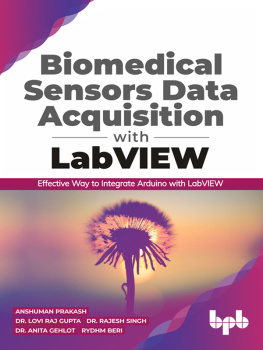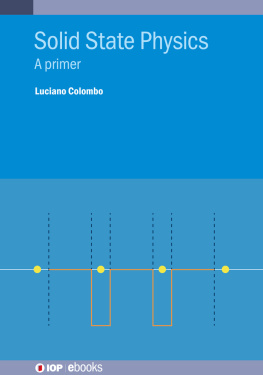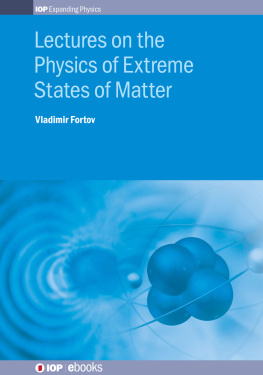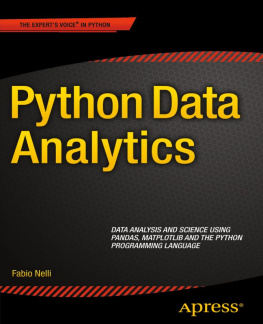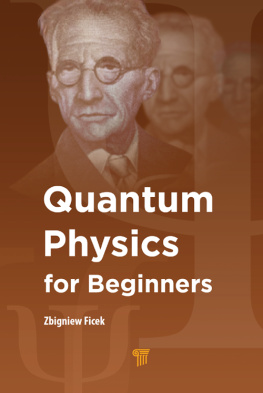Experimental Physics
Principles and Practice for the Laboratory
Experimental Physics
Principles and Practice for the Laboratory
Edited by Walter Fox Smith

MATLAB is a trademark of The MathWorks, Inc. and is used with permission. The MathWorks does not warrant the accuracy of the text or exercises in this book. This books use or discussion of MATLAB software or related products does not constitute endorsement or sponsorship by The MathWorks of a particular pedagogical approach or particular use of the MATLAB software.
CRC Press
Taylor & Francis Group
6000 Broken Sound Parkway NW, Suite 300
Boca Raton, FL 33487-2742
2020 by Taylor & Francis Group, LLC
CRC Press is an imprint of Taylor & Francis Group, an Informa business
No claim to original U.S. Government works
Printed on acid-free paper
International Standard Book Number-13: 978-1-4987-7847-3 (Hardback)
This book contains information obtained from authentic and highly regarded sources. Reasonable efforts have been made to publish reliable data and information, but the author and publisher cannot assume responsibility for the validity of all materials or the consequences of their use. The authors and publishers have attempted to trace the copyright holders of all material reproduced in this publication and apologize to copyright holders if permission to publish in this form has not been obtained. If any copyright material has not been acknowledged please write and let us know so we may rectify in any future reprint.
Except as permitted under U.S. Copyright Law, no part of this book may be reprinted, reproduced, transmitted, or utilized in any form by any electronic, mechanical, or other means, now known or hereafter invented, including photocopying, microfilming, and recording, or in any information storage or retrieval system, without written permission from the publishers.
For permission to photocopy or use material electronically from this work, please access www.copyright.com (http://www.copyright.com/) or contact the Copyright Clearance Center, Inc. (CCC), 222 Rosewood Drive, Danvers, MA 01923, 978-750-8400. CCC is a not-for-profit organization that provides licenses and registration for a variety of users. For organizations that have been granted a photocopy license by the CCC, a separate system of payment has been arranged.
Trademark Notice: Product or corporate names may be trademarks or registered trademarks, and are used only for identification and explanation without intent to infringe.
Visit the Taylor & Francis Web site at
http://www.taylorandfrancis.com
and the CRC Press Web site at
http://www.crcpress.com
Contents
Walter Fox Smith
Walter F. Smith
Walter F. Smith
Paul Thorman
Grace McKenzie-Smith
Walter F. Smith
Walter F. Smith
Brian Collett
Paul Freeman and Jami Shepherd
Walter F. Smith
Justin Peatross and Michael Ware
Walter F. Smith
Joseph Kozminski
Melissa Eblen-Zayas
Walter F. Smith
Mason Klein
Nathan C. Keim
Robbie Berg and Glenn Stark
Jay Sharping and Walter F. Smith
Enrique J. Galvez
Brett Fadem
The authors of this book deeply thank the following people, each of whom has put in many hours specifically for this book, testing experiments, organizing groups of student testers, providing insightful feedback, helping with editing, and creating figures. Without their help, this book would not have been possible: Eric Beery, Charles Bene, Ayesha Bhika, Travis Crawford, Jackson Davis, John Dusing, Sara Fadem, Michael Fernandez, Moira Ferrer, Helena Frisbie-Firsching, Rebeckah Fussell, Shamira Gonzalez, Lou Han, Charles Holbrow, Sunxiang Huang, Merritt Jacob, Meredith Jones, Lucas Kasle, Julia Kotler, Brian Kroger, Sasha Levine, Kate Matthews, Oliver Maupin, Aidan McGuckin, Marian McKenzie, Dani Medina, Saul Medrano, Alan Mendez, Richard Morash, Axel Moreen, Carly Press, Kristina Qualben, Margarita Rivers, Adeeb Saed, James Silva, Jonathan Simpson, Jeanette Smit, Greg Soos, Emily Swafford, Elizabeth Teng, Ryan Terrien, Kelly Tornetta, James Vickery, Jonam Walter, Longqi Wu, Shufan Xia, and Hongwen Yu.
We are also grateful to the many students in our classes over the last several years who have done the labs in this book, and because of their hard work and enthusiasm have given us critical feedback.
The development of the labs in was funded by grants to Prof. Enrique Galvez from the divisions of Undergraduate Education and Physics of the National Science Foundation.
To the Student
You are holding the most important textbook ever written. Im being humorous, of course, but only partly. Science is the most important field. Physics is the most important science; in addition to the amazing, world changing discoveries made in physics itself, physics underlies all the other sciences and fields of engineering, and is responsible directly or indirectly for the biggest advances in them. Physics is based on experimental results, so the most important physics book is about experimental physics. This is by far the best experimental physics book ever written. (For example, its the only one written by a team of experts in each subfield of experimental physics, each of us having a deep devotion to undergraduate education.)
If youre using this book as part of a course, buckle up! You will find yourself challenged in ways youve never been before. You may find that the course is harder or less hard than other advanced physics courses youve taken, but it will definitely be very different. Youll be asked to master techniques that are used in cutting-edge research labs, to think very deeply about what youre doing, and (as you progress through the course) to become more independent as an experimental physicist, to design your own experiments, troubleshoot them yourself, and develop your own models to explain what you see.
Your approach to this course must be different from what youve done before . You truly have to do the pre-lab reading before lab, and far enough before that you can ask your instructor or classmates about anything that is unclear before lab. Otherwise, you will find yourself totally lost in lab, understanding only a small fraction of what youre supposed to, using more of the instructors time than is your fair share, and having to stay later than the other students.
If you put in the effort needed to prepare properly, you will find much delight in the labs. Youll also find plenty of frustration thats part of experimental physics. But solving the problems and puzzles that arise will be deeply satisfying.
Perhaps you will come up with a question that you and your instructor think many other students would have. Please email it to me, Walter F. Smith, wsmith@haverford.edu. I will add it to the FAQ on the books website, with credit to you and your instructor. (You can ask not to be credited if you prefer.) Also, please email me with any other suggestions for the book.
For each chapter, please look at the resources on the books website, ExpPhys.com . There, you will find important updates, additional instructional materials, links to related research, and occasional amusing anecdotes and other content.
Happy experimenting!
To the Instructor
Advanced lab courses have two central goals that are in tension with each other. One is concrete: to teach students about the most important experimental and data analysis techniques. This is most efficiently accomplished with a series of well-defined, programmed exercises. However, there is also an essential and more abstract goal: to transform students, at least partly, into independent experimentalists. Students should learn how to formulate worthwhile research questions, and how to discover what is already known about the area of research. They should begin to understand the strengths and weaknesses of the range of experimental techniques that might be applied. They should become more confident in their ability to design, assemble, and debug experimental apparatus, to use it to take meaningful data, and to analyze the data in a way that most clearly shows its meaning.


